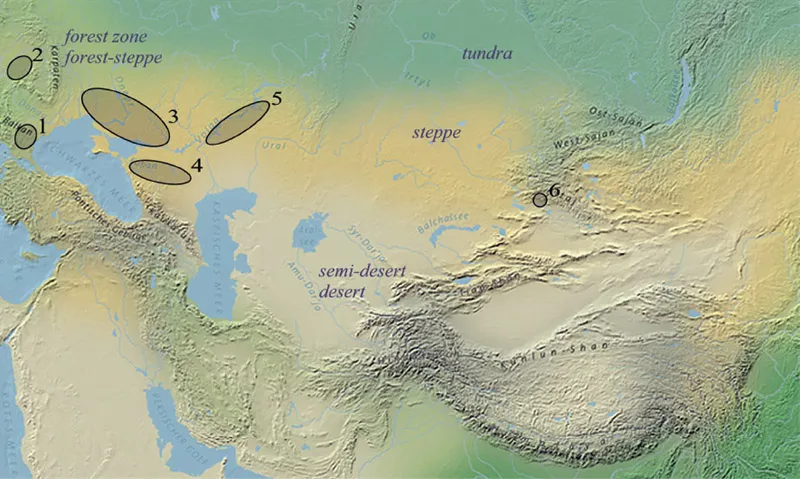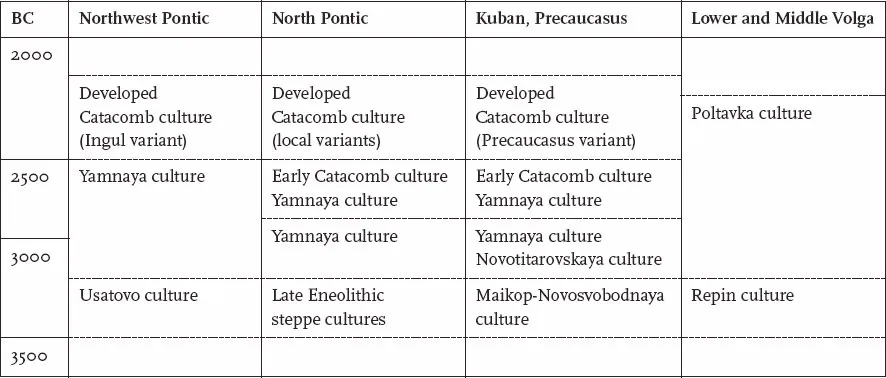![]()
1 Introduction
Mobility, migration and subsistence strategies of past societies have always been of major importance in archaeological research, and this interest has a broader appeal now as ‘The West’ feels the combined effects of increased labour mobility, simplified mobility structures within the European Union and migrations from areas of conflict or poverty to countries with more stable political and economic systems.
The West Eurasian steppe, between about 3500 BC and 2000 BC, is particularly interesting in respect to past mobility behaviour. For almost one century, archaeologists have been trying to understand the lifestyle, subsistence economies and possible migrations of the late Eneolithic, the Early and Middle Bronze Age1 Eurasian steppe communities. In spite of intense research and the discovery of important archaeological sites and finds, the picture remained unchanged and has only transformed in the last few decades to become ‘one of the most dynamic fields in the whole ambit of prehistoric studies’ (Renfrew, 2009, XVI). The second half of the 4th and the 3rd millennia BC are of particular interest, because a new extensive pastoral economy was accompanied by an unknown mobile economy and a new social organisation was introduced to the Eurasian steppes (Kristiansen/Larsson, 2005, 140). This time period is associated with a burial tradition that included the erection of burial mounds, called kurgans in Russian, in large parts of the West Eurasian steppes. This particular burial tradition, the paucity of archaeological evidence for permanent settlement sites and the widespread occurrence of similar cultural artefacts led many researchers to assume that the Early Bronze Age steppe communities were semi-nomadic2 and pastoralist3. Animal bone assemblages in the few excavated settlement sites point towards a transition to a subsistence economy based on animal herding at the end of the 4th and the beginning of the 3rd millennia BC (cf. Černych et al., 1998, 244; Kaiser, 2012, fig. 83–85), indicating an economy based primarily on cattle with horses and sheep/goats playing minor roles (Kristiansen/Larsson, 2005, 173). This form of subsistence is often seen as only being effective when associated with circular mobility and pastoralism. Pastoral strategies ‘contribute to a heightened degree of variation in mobility and subsistence strategy, in settlement ecology, and in commercial activity’ (Frachetti, 2009, 41). An increased level of mobility might be represented in contemporaneous burial contexts including wheel and wagon burials. Early archaeological evidence of wheeled transport is associated with the northwest Pontic Tripolye culture, and the remains of wagons were frequently deposited in Yamnaya and Catacomb culture graves in the North Pontic and southern Russia (Kohl, 2002, 161; Kaiser, 2007; 2010). The concurrent appearance of similar traditions such as kurgans and other features of the burial ritual in the Carpathian-Balkan region led archaeologists to suggest the possibility of human migrations between the North Pontic regions and areas to the west of the distribution area. The early Iron Age in the steppes is tightly connected with the Scythians. In the 1st millennium BC, Scythian communities and groups that were culturally connected to them inhabited the Eurasian steppe belt. On the basis of archaeological and historical evidence, some of these communities are assumed to represent the first true nomads4, not only living an unsettled lifestyle but also being involved in large-scale migrations.
The application of scientific methods to answer questions on mobility, possible migrations and dietary patterns has only entered archaeological research in the last few decades. In this study, questions of mobility and dietary patterns of the Eneolithic, the Early and Middle Bronze Age and the Iron Age societies in the West Eurasian steppes are addressed using multi-isotope analysis, namely 87Sr/86Sr, δ18O, δ15N and δ13C analyses. Strontium isotope analysis enables the identification of human and faunal movements between various geological regions. In addition, oxygen isotope analysis is generally applied to reconstruct drinking water sources and identify the climatic environment that humans or animals inhabited due to the correlation of oxygen isotope ratios in skeletal tissue with local meteoric water. Both give valuable hints to small- and large-scale mobility of the prehistoric societies of West Eurasia. The analyses of carbon and nitrogen stable isotopes of skeletal collagen of the same humans help to classify their dietary backgrounds and to characterize the economy of the steppe communities. As a subproject of the research group A II ‘Spatial effects of technological innovations and changing ways of life’ within the Excellence Cluster Topoi, the present study can be distinguished from the majority of the huge range of recent stable isotope studies since it is the first large-scale investigation of mobility and subsistence patterns in an area that covers several thousand kilometres and several chronological periods. Running a study of this scale is only possible against the financial background of a research cluster such as Topoi. Other studies, however, focus on single sites which enables the reconstruction of the surrounding areas of usage to answer the questions raised above. The combined effect of a number of factors made the interpretation of the analyses more challenging than for some single site studies. These factors include the fact that the number of samples available per site in each age range was often small, that comparative data was sometimes inadequate, that few other studies have been undertaken for these time periods in these areas, and most crucially that the application of stable isotope analysis to mobile communities with unknown places of residence is fraught with difficulties. Nevertheless, this doctoral thesis forms the first step in expanding the biogeochemical data set from the West Eurasian steppes and breaks new ground by applying a combination of different isotopic systems to an area of vast chronological and spatial dimensions. The main objectives are as follows: 1) Characterise the mobility and subsistence patterns of the archaeological communities under discussion, 2) identify potential Early Bronze Age migrations from the West Eurasian steppes to the steppe-like plains in parts of Eastern Europe, and 3) evaluate the applicability of stable isotope analyses in this context.
The study focuses on the West Eurasian steppes, namely the North Pontic steppe and its adjacent areas. The ecological region of the West Eurasian steppe expands from the plains in southeast Europe at its westernmost part, to the Ural Mountains in the east. The North Pontic steppes extend approximately 1000 km in an east-west direction and 500 km from north to south. They are principally located in the southern part of present-day Ukraine, bounded by the semi-deserts towards the coasts of the Black Sea and the Azov Sea in the South. The Danube River defines the western border, while the lower Don River limits the area to the east and the forest-steppes border to the north (Kremenetski, 2003, 11).
Fig. 1.1 | Micro regions and single sites selected for multi-isotope analysis in respect to vegetation zones (underlying map © D. Bordon).
Within this vast area of West Eurasia, multiple sites or micro regions5 have been selected at random for isotopic analysis. All of them are located in the steppe, at the border to the forest-steppe or in deciduous hardwood forest. Figure 1.1 shows the Eneolithic, Early and Middle Bronze Age sites in modern Bulgaria (1), Hungary (2), the North Pontic/Ukraine (3), southern Russia, including one site in the Kuban region and one site in the northwest Caspian steppes (4), and at the Volga River (5). In addition, several sites in the context of the Scythian period, in the North Pontic region (3) and the Altai Mountains (6) were chosen for isotope analysis.
The study addresses the Late Eneolithic and the Early and Middle Bronze Age, which equates roughly to the time between 3500 BC and 2000 BC (Table 1.1) when the North Pontic steppes and adjacent areas were predominantly inhabited by groups of the Yamnaya culture (late 4th to middle 3rd millennium BC) and the partly overlapping and subsequent Early and Developed Catacomb culture (early to late 3rd millennium BC). During this time, and principally during the period of the Yamnaya culture, different aspects of the burial traditions of cultures inhabiting parts of the East European lowlands suggest a cultural influence from the steppes. Samples from a number of Scythian sites dating to the second half of the 1st millennium BC were selected for the sake of comparison.
Chapter 1 introduces the study and its principle objectives and summarises its integrated approach geographically and chronologically. Chapter 2 provides the background information relevant to this study. Section 2.1 focuses on the prehistoric archaeology of the West Eurasian steppes during the 4th and 3rd millennia BC and the Iron Age Scythian period. The overview of the archaeological cultures examined in this study includes the history of research and the most important features in respect to this investigation. The methodological background of isotope analysis as a tool to identify mobility and dietary habits is introduced in section 2.2. This consists of the research history of the application of isotope analysis in archaeology, a short introduction to the geological and ecological conditions of the study area, followed by a discussion of human and faunal tissue as sample materials. Chapter 3 is dedicated to the introduction of the study area and sample sites. The description of the study sites and the sample material is arranged in a chronological and geographical order. A brief introduction to the respective regional geology is followed by an explanation of the sampling strategy and sample selection, including archaeological and anthropological background information on the samples selected for analysis. Chapter 4 expands on the issue of mobility and migration. First, the current state of research, relevant theories and models and their significance for the study area are discussed (Section 4.2). Secondly, the methods used to investigate these questions, strontium (Section 4.3) and oxygen (Section 4.4) isotope analyses, are introduced. Both subchapters are divided into the following sections: The discussion of the basics of the methods is followed by the introduction of the selected sample material and complemented by the analytical protocols. The presentation of the results is complemented by the definition and discussion of samples that are consistent with ‘local’ and ‘non-local'. Section 4.5 then presents the combined results of strontium and oxygen isotope analysis and a more detailed discussion on ‘local’ and ‘non-local’ sampled individuals. Finally, Section 4.6 provides the synthesis and the conclusion of the 87Sr/86Sr and δ18O analyses in respect to the objectives of the study. Following this chapter, which mainly focuses on human mobility, the issue of faunal migration will be touched on in a case study using the example of a Globular Amphora cattle deposition in Zauschwitz, Germany (Chapter 5). Chapter 6 focuses on the investigation of possible dietary patterns of the Eneolithic, Early and Middle Bronze Age societies in the study area using carbon and nitrogen isotope analysis. This study is presented separately due to marginally differing data bases. The introduction of the methodological basics (Section 6.2) and the sample material deriving from several exemplarily selected sites in the North, the West Pontic and the Kuban region (Section 6.3) is followed by the description of the analytical protocol (Section 6.4) and the presentation (Section 6.5) and discussion (Section 6.6) of the analytical data. Chapter 7 summarises the key conclusions that have been drawn throughout the course of this study. Furthermore, the applicability of the stable isotope analyses in the study area is evaluated and an outlook is given on possible future research. Finally, a conclusion of this study's main results is given in German and Russian.
Table 1.1 | Simplified chronological overview of the second half of the 4th millennium and the 3rd millennium BC in the North Pontic and its adjacent areas (modified after Rassamakin, 1999, 77 table 3.2; Kaiser, 2005, 267 table 1).
![]()
2 Background
2.1 Archaeological background
2.1.1 Introduction
The sample material for the present study derives from cultures of the Middle1 and Late Eneolithic, the Early and Middle Bronze Age2 and the Iron Age. These cultural entities will be characterised briefly below.
2.1.2 The (Middle and) Late Eneolithic period in the North Pontic steppe
2.1.2.1 History of research
Research into th...


